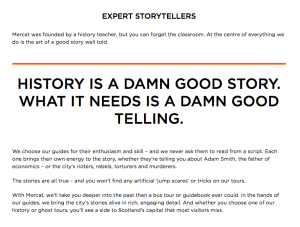The lure of ghost stories and hidden tunnels is what tends to draw tourists to the Old Town section of Edinburgh, Scotland, but it’s in the real historical sites where the story comes alive. Crichton Easton is a former employee with Edinburgh’s Mercat Tours, the most popular and trusted historical interpretation and touring company in the city. He laughs at the transformation that he witnesses in tourists when moving from supposedly haunted sites, to ones where real people lived, worked, and died. “The ghosts elicit giggles,” he says, “but the real history gets the gasps, and ‘ooohs, and the proper interest.’”

Mercat is contracted by the city of Edinburgh to do all “official” tours in the Old Town and along the Royal Mile. The Old Town contains Reformation-era buildings still situated on a Medieval street plan, and the Royal Mile is a long stretch of road that serves as the central hub of the Old Town, running from Edinburgh Castle to the ruins of Holyrood Abbey. While the company’s most popular attraction is the evening Ghost Tour, Easton also gave tours and site interpretations along the Royal Mile during the day, and worked briefly as a site interpreter at various World War I sites in Belgium and France. The tour routes, Easton said, were strict and specific, having been written by the directors of the company. “The directors,” he added, “are all former Heads of History at schools in Edinburgh.” Guides aren’t required to go by a script, though, and are often encouraged to make their tours personal and distinctive.

Even in their advertisements, Mercat Tours boasts that all of their guides and site interpreters are university trained, having at least a BA in History or something similar. Easton received his BA in Honors History at the University of Stirling in 1992, his post-graduate diploma in Tourism and Hospitality Management from Napier University of Edinburgh in 1993, and a post-graduate certificate in Education with a distinction of History Teaching from Glasgow University in 2001. He says that his additional degrees more than prepared him for the job at Mercat, and even allowed him to rise through the ranks to interim manager of the Edinburgh branch of the company.
The company’s directors carefully research each site, and routes are often changed when new history or archaeological evidence is found. Interpreters also know to leave time for extra stops, as tourists always have questions or feedback that would invite further exploration of certain places across town. Inevitably, Easton added, tourists would want to know about things they had seen in films, or on TV. Dispelling those myths always felt like a job well done, though Mercat did eventually give in and create a tour of sites seen in the book/television series Outlander.
Easton loved his job with Mercat, relaying stories of giving tours to Barry Gibb (twice!), to the Russian Ambassador to Scotland, and to a NASA astronaut who was working on the tiles of the Space Shuttle. But he also understands the importance of making history relevant and exciting to those who might think otherwise. One has to imagine that in this company, making the history tours just as worthwhile as the ghost tours can be a challenge. But he says it’s not impossible. “Be confident in what you are talking about. Have a theatrical slant — once did a tour with 250 people on it — very hard work but worth it.”
Okay, that sounds like a dream job…
This sounds really interesting. I guess I forget that history is big with some tourism attractions, and places beyond museums and National Parks need knowledgeable guides who aren’t just reciting a script.